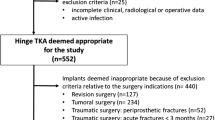Abstract
Objective
Restoring stability after total knee arthroplasty (TKA) and improving joint function using a cemented rotating hinge system.
Indications
Ligament instability and/or osseous defects (including Anderson Orthopaedic Research Institute [AORI] classification type II defects) after primary TKA or TKA revision surgery.
Contraindications
Distal femoral or proximal tibial bowing requiring implant systems that provide femoral or tibial offset stems. Persistent periprosthetic infection. Poor therapeutic compliance. AORI type III defects.
Surgical technique
Medial arthrotomy. Femoral and tibial component removal with small saw blades and chisels. Intramedullary alignment for the tibial and femoral cuts. Debridement and removal of membranes and cement remnants. Reconstruction of joint line and correct TKA alignment. Trial reduction. Cement fixation.
Postoperative management
Unrestricted range of motion, partial weight bearing for 4 weeks.
Results
Between 2012 and 2013, 18 patients suffering from ligament insufficiency after TKA were revised using the described system and included in a prospective study protocol. The mean follow-up was 37 months (range 30–46 months). There was a significant improvement of the Oxford Knee Score (OKS) from 19 (range 7–29) preoperatively to 29 (range 10–45) postoperatively (p = 0.004). The Knee Society Score (KSS) knee assessment subscore improved from 35 (range 9–70) to 67 (range 35–97) (p = 0.002) and the pain score from 7 (range 0–50) to 24 (range 0–50) (p = 0.008).
Zusammenfassung
Operationsziel
Funktionsverbesserung und Behandlung der Knieprotheseninstabilität durch Wechsel auf eine vollständig zementierte, rotationsachsgeführte Knieprothese.
Indikationen
Bandinsuffizienz und/oder Knochenverlust (bis einschließlich AORI [Anderson Orthopaedic Research Institute] Typ-II-Defekte) nach primärer Knieprothesenimplantation oder Revision.
Relative Kontraindikationen
Höhergradige femorale oder tibiale Achsabweichungen, die ein stielgeführtes Revisionssystem mit Offset-Varianten notwendig machen. Persistierende periprothetische Infektion. Fehlende Compliance. Knochendefekt AORI Typ III.
Operationstechnik
Mediale Arthrotomie, Entfernung der einliegenden femoralen und tibialen Komponenten mit kleinen, flachen Sägeblättern und Meißeln. Intramedulläres Alignment für den tibialen und femoralen Sägeschnitt. Débridement und Entfernen von Membranen und Zementresten. Knochensparende Resektion für eine suffiziente Prothesenauflage. Rekonstruktion der Gelenklinie und korrektes Prothesenalignment. Probereposition. Vollständig zementierte Verankerung.
Nachbehandlung
Keine Bewegungseinschränkung. Teilbelastung für 4 Wochen.
Ergebnisse
In einer prospektiven Studie konnten 18 Patienten eingeschlossen werden, welche zwischen 2012 und 2013 aufgrund einer klinisch relevanten Instabilität nach Knieprothesenimplantation revidiert wurden. Das durchschnittliche Follow-up lag bei 37 Monaten (30–46). Es zeigte sich eine signifikante Verbesserung des OKS (Oxford Knee Score) von 19 (7–29) auf 29 (10–45) Punkte (p = 0,004), des KSS (Knie Funktion Scores) von 35 (9–70) auf 67 (35–97) Punkte (p = 0,002) und des Schmerz-Scores von 7 (0–50) auf 24 (0–50) Punkte (p = 0,008).














Similar content being viewed by others
References
Boelch SP, Arnholdt J, Holzapfel BM et al (2018) Revision knee arthroplasty with rotating hinge systems in patients with gross ligament instability. Int Orthop. https://doi.org/10.1007/s00264-018-3982-z
Boelch SP, Jakuscheit A, Doerries S et al (2018) Periprosthetic infection is the major indication for TKA revision—experiences from a university referral arthroplasty center. BMC Musculoskelet Disord 19:395
Bozic KJ, Kurtz SM, Lau E et al (2010) The epidemiology of revision total knee arthroplasty in the United States. Clin Orthop Relat Res 468:45–51
Chang MJ, Lim H, Lee NR et al (2014) Diagnosis, causes and treatments of instability following total knee arthroplasty. Knee Surg Relat Res 26:61–67
Cui WQ, Won YY, Baek MH et al (2006) Variations of the ‘grand-piano sign’ during total knee replacement. A computer-simulation study. J Bone Joint Surg Br 88:1441–1447
Fehring TK, Baird R 3rd, Park B et al (2019) When polyethylene exchange is appropriate for prosthetic knee instability. J Am Acad Orthop Surg 3:e31
Guenoun B, Latargez L, Freslon M, Defossez G, Salas N, Gayet LE (2009) Complications following rotating hinge Endo-Modell (Link) knee arthroplasty. Orthop Traumatol Surg Res. 95(7):529–536. https://doi.org/10.1016/j.otsr.2009.07.013
Indelli PF, Giori N, Maloney W (2015) Level of constraint in revision knee arthroplasty. Curr Rev Musculoskelet Med 8:390–397
Laskin RS (2002) Joint line position restoration during revision total knee replacement. Clin Orthop Relat Res. https://doi.org/10.1097/00003086-200211000-00029
Ohmori T, Kabata T, Kajino Y et al (2018) Usefulness of the “grand-piano sign” for determining femoral rotational alignment in total knee arthroplasty. Knee 25:15–24
Pereira GC, Von Kaeppler E, Alaia MJ et al (2016) Calculating the Position of the Joint Line of the Knee Using Anatomical Landmarks. Orthopedics 39:381–386
Rodriguez-Merchan EC, Gomez-Cardero P, Martinez-Lloreda A (2015) Revision knee arthroplasty with a rotating-hinge design in elderly patients with instability following total knee arthroplasty. J Clin Orthop Trauma 6:19–23
Servien E, Viskontas D, Giuffre BM et al (2008) Reliability of bony landmarks for restoration of the joint line in revision knee arthroplasty. Knee Surg Sports Traumatol Arthrosc 16:263–269
Sheth NP, Bonadio MB, Demange MK (2017) Bone loss in revision total knee Arthroplasty: evaluation and management. J Am Acad Orthop Surg 25:348–357
Weißenberger M, Petersen N, Bölch S et al (2020) Revision of unicompartmental knee arthroplasty using the in situ referencing technique. Oper Orthop Traumatol. https://doi.org/10.1007/s00064-020-00656-w
Author information
Authors and Affiliations
Corresponding author
Ethics declarations
Conflict of interest
J. Arnholdt, S.P. Boelch, F. Dogan, M. Hoberg, B.M. Holzapfel and M. Rudert declare that they have no competing interests.
For this study, we received institutional review board approval (approval no. 195/10) from the university.
Additional information
Editor
D.C. Wirtz, Bonn
Illustrator
R. Himmelhan, Mannheim
Jörg Arnholdt and Sebastian P. Boelch have equally contributed as first author to this article.
Rights and permissions
About this article
Cite this article
Arnholdt, J., Boelch, S.P., Dogan, F. et al. Revision arthroplasty with rotating hinge systems for total knee arthroplasty instability. Oper Orthop Traumatol 32, 298–308 (2020). https://doi.org/10.1007/s00064-020-00663-x
Received:
Revised:
Accepted:
Published:
Issue Date:
DOI: https://doi.org/10.1007/s00064-020-00663-x




